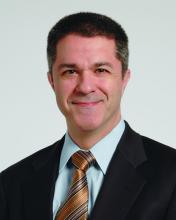The use of oncology clinical pathways (OCPs) is rapidly rising as more data suggest that they can reduce cost and improve quality. But amid the advantages to pathways, there are growing concerns about hidden conflicts of interest.
“There is a lot of promise from these pathways in delivering the right care to the right patient at the right time,” said Bobby Daly, MD, an oncologist and health services researcher at Memorial Sloan Kettering Cancer Center in New York. “But oncologists and patients really want to understand how these pathways are being developed. The issue of transparency is one that patients and providers feel strongly about.”
A recent research letter coauthored by Dr. Daly in JAMA Oncology highlights the crossroads of pathways and financial conflicts. For the study, Dr. Daly and his colleagues reviewed the Centers for Medicare & Medicaid Services Open Payments database to abstract 2015 financial conflicts of interest for the 2016 voting members of three OCP vendors: Value Pathways (a collaboration of McKesson Specialty Health, US Oncology, and the National Comprehensive Cancer Network), the medical oncology committee chairs for Via Oncology, and the medical advisory board for eviti. Investigators found that nearly all physicians on the panels received nonresearch payments, including 92% of US Oncology voting members, 86% of NCCN voting members, 84% of Via Oncology chairs, and 69% of the eviti medical advisory board.While collaboration with industry is the key to innovation, Dr. Daly wrote that “to ensure patient and clinician trust and maintain their momentum in the value space, pathway developers will need to be transparent about [financial conflicts of interest] and how those interests are managed.”
Pathways: What’s the problem?
Clinical pathways are defined as detailed, evidence-based treatment protocols for delivering quality cancer care to patients with specific disease types and stages. Adoption of these protocols has swiftly grown in recent years, with close to 60% of oncologists currently using or planning to use pathways, according to a 2017 report from the American Society of Clinical Oncology (ASCO). Academic medical institutions, health care providers, commercial organizations, and health insurance companies are all using these pathways.But as pathways have become more prevalent, concerns have emerged among physicians about who is making pathway treatment decisions and, specifically, about instances in which medications are being selected without disclosure of investments or financial relationships that could influence those decisions, said Robin Zon, MD, chair of the ASCO Task Force on Clinical Pathways.
“In addition, there have been concerns about the methodology of how treatments decisions are made with regard to efficacy, toxicity, and cost, as well as the weighting of these factors in making decisions for the pathway program,” Dr. Zon said in an interview.
Taken together, the mounting questions led to an analysis and by the ASCO task force.
“What the task force found was that standards defining high-quality pathways did not exist, so we became concerned that there could be a risk for wide variations with regards to the quality, utility, functionality, and impact of pathway programs,” Dr. Zon said.
The findings were the catalyst behind a March 2016 ASCO policy statement aimed at ensuring that clinical pathways in oncology promote – not hinder – cancer care. The task force called on pathway developers to adopt a process that was consistent and transparent to all stakeholders and to disclose potential conflicts of interest by the companies and individuals involved in pathway development.
“The criteria were developed to address the multiple issues brought to our attention by ASCO members and to be used as possible standards for pathway development, implementation, and evolution,” Dr. Zon said.
The push for more transparency is directed at for-profit companies and health plans that are developing and promoting their pathways, said Matt Kalaycio, MD, chair of hematology and medical oncology at Cleveland Clinic Taussig Cancer Institute. An estimated 60 U.S. health plans are currently implementing oncology pathways, and more than 170 million patients covered by the plans are potentially treated under a plan-sponsored pathway program, according to ASCO.Meanwhile, the Cleveland Clinic has been utilizing pathways for more than 5 years and has published nearly 50 clinical pathways related to cancer care, Dr. Kalaycio said.
“Our care paths were designed to help physicians make clinical decisions that are in the best interest of their patients and the Cleveland Clinic,” he said in an interview. “These care paths are here for clinical reasons, not for financial reasons – we might ultimately use them to make financial decisions, but that’s not why they were developed. In contrast, the [JAMA Oncology study] is referring to pathways that are being developed by for-profit companies to control cost – big, big difference.”
The problem is that some insurers want to hide the identity of their advisors and how much they are being paid, which creates uncertainty about the validity of their pathways, he said. Dr. Kalaycio noted that the individuals selected for pathway panels and committees are often those who conducted the studies that the pathways are based upon and that those studies are frequently supported by the pharmaceutical industry.
“There is always going to be some degree of conflict of interest and as long as that’s disclosed, that’s fine,” he said. “It’s when you try to hide who’s getting paid for what that you get into trouble because you can’t say with certainty that someone’s not getting paid off.”
To address the transparency void, the California legislature in 2017 introduced the Oncology Clinical Pathways Act. The bill would have required health plans that develop and implement OCPs to provide the names, qualifications, affiliations, and conflicts of anyone involved in the research or analysis for an oncology clinical pathway if it were requested by a physician or surgeon. The bill died in committee.




